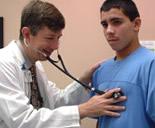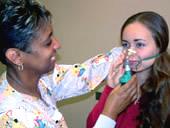Clinical Scenarios - Ozone



Clinical Scenario 1
A 12-year-old girl arrives at your office with her mother for an evaluation of the child's asthma. The mother reports that yesterday her daughter developed chest tightness and shortness of breath at soccer practice. A couple of puffs on her albuterol inhaler relieved the symptoms and allowed her to finish the practice. Rescue medication was needed again after dinner, and the girl woke up during the night and this morning with wheezing and shortness of breath. A mild expiratory wheeze is still perceptible. The mother says generally her daughter has been doing fine since starting a daily regimen of ICS six months ago. There have been only two episodes of wheezing and both of them have been during the nights following soccer practices on Code Red ozone air quality days. The mother asks you, "Do you think ozone caused her wheezing? Should I make her skip practice if it's a Code Red air quality day? Is it safe for her to go out at all on those days?"
- Discussion
Clinical Scenario 1: A 12-year-old girl arrives at your office with her mother for an evaluation of the child's asthma. The mother reports that yesterday her daughter developed chest tightness and shortness of breath at soccer practice. A couple of puffs on her albuterol inhaler relieved the symptoms and allowed her to finish the practice. Rescue medication was needed again after dinner, and the girl woke up during the night and this morning with wheezing and shortness of breath. A mild expiratory wheeze is still perceptible. The mother says generally her daughter has been doing fine since starting a daily regimen of inhaled corticosteroids six months ago. There have been only two episodes of wheezing and both of them have been during the nights following soccer practices on Code Red ozone air quality days. The mother asks you, "Do you think ozone caused her wheezing? Should I make her skip practice if it's a Code Red air quality day? Is it safe for her to go out at all on those days?"
Discussion:
1. Ozone is a known trigger for exacerbating asthma. As with other triggers, some individuals are more likely to be affected by ozone than others. For each individual, the increased likelihood of having an asthma attack is influenced by baseline asthma status, by individual sensitivity to ozone, and by the dose of ozone inhaled (dose = the product of concentration, minute ventilation, and duration of exposure). An individual whose asthma is quiescent, who has historically not had exacerbations on days when ozone levels are high, and who will be exercising only for a short time on a Code Orange day is less likely to have an ozone related asthma attack than is an individual with a recent viral upper respiratory infection, who is known to be sensitive to ozone, and who will be performing intense, prolonged outdoor exercise on a Code Red day.
2. Balanced response. There is no single "correct" course of action for all individuals with asthma on Code Orange or Red days. Rather the potential costs and benefits of any action must be weighed. On the one hand, physical activity has obvious health benefits, and participation in a particular activity may be of importance to an individual. On the other hand, ozone exposure can increase the probability of an asthma attack. Those with poorly controlled asthma or who are known to be particularly sensitive to ozone exposure will probably benefit more by reducing exposure or increasing medication use than those who are less sensitive to ozone. All asthmatics with an Asthma Action Plan should carefully monitor their asthma status and follow the recommendations of their plan for any sign of worsening asthma.
3. Exposure reduction. As with other agents that are known to exacerbate asthma, reduction of exposure to ozone is likely to reduce the probability of an asthma attack. By reducing the dose of ozone inhaled, exposure can be reduced on heavily polluted days. Because indoor levels are usually only 20% to 80% of outdoor levels, reducing time spent outdoors or reducing the level or duration of outdoor activity during the times of day that ozone levels tend to be highest in your area can be effective measures. For organized sports, practices can be held at traditionally less polluted times of day and activities can be reduced or shortened on more polluted days. Anyone known to respond adversely to ozone should include exposure reduction in his or her Asthma Action Plan.
4. Medication. Because no information specific to treatment or prevention of ozone-induced asthma exacerbations is available, one should probably approach the medical management of asthma during high ozone seasons as one would approach exposures to other asthma triggers. One would likely treat the individual with an occasional exposure differently from an individual attending a two-week soccer camp with long, intense workouts every day during the high ozone season. Although there is some evidence that antioxidant (Vitamins C and E) supplementation in individuals with asthma can modestly reduce the neurally-mediated lung function changes due to ozone exposure, such treatment does not appear to reduce the inflammatory response to ozone, and there is no evidence that it would reduce asthma attacks. There is some evidence that regular treatment with inhaled steroids results in a blunted inflammatory response to ozone exposure without an effect on immediate lung function and symptom changes. Whether this reduction in the inflammatory response would result in a decreased probability of a later asthma exacerbation has not been addressed.
Clinical Scenario 2
During the well-child physical exam of a 3-year-old boy, the mother indicates that she is starting back to work and, for four days a week, she will be leaving her son in a local day care. She has a few questions about the day care situation she has found for him. One of the questions concerns outdoor playtime on days with high levels of air pollution. It is the daycare's policy to let the children go out for an hour in the morning on Code Orange or Red air quality days. The mother asks you, "Shouldn't they keep him in on days when air pollution levels are high?"
- Discussion
Clinical Scenario 2: During the well-child physical exam of a 3-year-old boy, the mother indicates that she is starting back to work and, for four days a week, she will be leaving her son in a local day care. She has a few questions about the day care situation she has found for him. One of the questions concerns outdoor playtime on days with high levels of air pollution. It is the daycare's policy to let the children go out for an hour in the morning on Code Orange or Red air quality days. The mother asks you, "Shouldn't they keep him in on days when air pollution levels are high?"
Discussion:
1. Long-term health effects. Although there is no conclusive answer as to whether long-term exposure to ozone can result in serious health effects in people without asthma, there is some evidence suggesting that long-term exposure may predispose one to development of new asthma and may interfere with the postnatal growth and development of the respiratory system. These potential effects may be related to the reversible respiratory epithelial injury and inflammation accompanying short-term exposure. On the other hand, long-term ozone exposure does not appear to account for a large part of the asthma or other respiratory disease in the population living in some cites of the United States with high ozone levels. Research in these areas will hopefully help quantify any health risks of long-term exposure and identify the determinants of exposure most responsible for any such effects.
2. Benefits of exercise. It is well known that active exercise promotes better health for children and adults. The well-documented benefits of exercise should not be given up as one tries to avoid potential health effects of ozone exposure. If one chooses to reduce outdoor activity when ozone levels are high, indoor activity should be increased on those days or outdoor activity should be increased at times of the day or on other days when pollution levels are lower.
3. Balanced response. Given the known health benefits of exercise, the inevitable scheduling of outdoor activities that may be important to one or one's children during high ozone periods, and the uncertainties of ozone health effects, it is hard to argue that one should never exercise outdoors on high ozone days. On the other hand, it would be prudent to minimize cumulative exposure when possible by reducing exposure on days when outdoor ozone levels are high (Code Orange or Red days) without reducing the overall level of physical activity. The inhaled dose of ozone (the product of concentration, minute ventilation, and duration of exposure) can be reduced on heavily polluted days by reducing the amount of time spent outdoors or reducing the level and duration of outdoor activity during the times of day that ozone levels tend to be highest in your area. In areas where ozone levels are routinely high, one might develop a schedule for outdoor activities that avoids the worst times of day and that allows for either rescheduling activities or reducing activity levels on bad days.
Clinical Scenario 3
A 32-year-old man comes in to the office with concerns about the exercise program he recently started. After discussing problems with a sore knee, he describes an episode of coughing and chest discomfort - like a burning sensation in the airways - that occurred recently. Although it was a Code Orange day for ozone, he decided to go for a run. Shortly after leaving his home, the man started coughing, so he slowed to a brisk walk. Even at that pace, he felt a burning sensation in his chest made worse by taking a deep breath. So he went home and rested on the couch. In about an hour the pain subsided. He asks you, "Can air pollution cause burning like that?"
- Discussion
Clinical Scenario 3: A 32-year-old man comes in to the office with concerns about the exercise program he recently started. After discussing problems with a sore knee, he describes an episode of coughing and chest discomfort - like a burning sensation in the airways - that occurred recently. Although it was a Code Orange day for ozone, he decided to go for a run. Shortly after leaving his home, the man started coughing, so he slowed to a brisk walk. Even at that pace, he felt a burning sensation in his chest made worse by taking a deep breath. So he went home and rested on the couch. In about an hour the pain subsided. He asks you, "Can air pollution cause burning like that?"
Discussion:
1. Health effects. Short-term ozone exposure can cause cough, pain or discomfort on deep inspiration, and shortness of breath during and immediately following exposure in otherwise healthy people. These symptoms are reversible and usually disappear within several hours of terminating exposure. There is some evidence suggesting that long-term exposure to high ozone levels may have long-term effects, but this is preliminary, and there is no information as to whether an acutely sensitive individual would be at more risk of a long-term effect. The limited data available indicate that the degree of sensitivity as measured by symptoms (e.g., cough) is not related to the degree of sensitivity as measured by the reactions in the respiratory tract (e.g., reversible respiratory epithelial cell injury and inflammation) that also accompany ozone exposure.
2. Inter-individual variability. Individuals vary in their responsiveness to ozone. This individual appears to be a more responsive individual. Although there is variability in responsiveness within an age group, in general, young adults (teens to thirties) appear to be more responsive than older adults (fifties to eighties), though children do not appear to be more sensitive than young adults with regard to respiratory symptoms.
Clinical Scenario 4
A 68 year old patient comes to your office for a routine visit six months following an uncomplicated myocardial infarction. He has just completed cardiac rehabilitation and is asking your advice about his proposed ongoing exercise program. He has experienced no chest pain or shortness of breath since his MI, and his hypertension is controlled. He would like to exercise for 30 minutes on a cycle ergometer on three days per week at a local gym and take a 60 minute outdoor walk on two other days. However, he heard on NPR that the National Research Council has found that more people are likely to die on days when ozone pollution is bad and wonders if there is anything he can do to avoid that risk.
- Discussion
Clinical Scenario 4: A 68-year old patient comes to your office for a routine visit six months following an uncomplicated myocardial infarction (MI). He has just completed cardiac rehabilitation and is asking your advice about his proposed ongoing exercise program. He has experienced no chest pain or shortness of breath since his MI, and his hypertension is controlled. He would like to exercise for 30 minutes on a cycle ergometer on three days per week at a local gym and take a 60 minute outdoor walk on two other days. However, he heard on NPR that the National Research Council has found that more people are likely to die on days when ozone pollution is bad and wonders if there is anything he can do to avoid that risk.
Discussion:
1. Mortality risk of ozone exposure. It is true that non-accidental mortality rates are generally higher on days when ozone concentrations are high than when they are low. Daily death rates increase approximately 0.5% for each 20 ppb increase in the 24-hour average ozone concentration, and available data suggest that this effect is present even at very low concentrations of ozone. Although this suggests that ozone is responsible for many deaths in the total population, the absolute increase in risk to the average individual on any given day is quite low. For example, a 0.5% increase in daily death rates for an individual with a 10 year average life expectancy increases the daily probability of death from 0.0001176 to 0.0001182 or approximately 6 additional deaths per day per 10 million people. There appears to be some variability in the effect of ozone across different regions with the risk potentially being somewhat higher in some areas and somewhat lower in others. It is also true that elevated levels of particle pollution, another air pollutant, have been observed to be associated with increased daily mortality and with adverse events in patients with underlying cardiovascular disease.
2. Benefits of exercise. The benefits of regular exercise on many aspects of physical and mental health have been well documented as have the benefits for reducing the probability of a recurrent MI in those with underlying cardiovascular disease. This patient should be strongly encouraged to maintain a program of regular exercise to realize these well established benefits.
3. Balanced response. The optimal solution for this patient is to continue his exercise program as planned while taking several steps that may reduce his risk from air pollution. These steps involve reducing exposure when feasible without creating barriers to exercise, and they require the patient to become familiar with the daily Air Quality Index and with temporal patterns of air pollution in his location. Because outdoor concentrations of ozone are almost always higher than indoor concentrations, the patient could vary his days of indoor and outdoor exercise such that he exercised indoors on days when ozone concentrations were highest and outdoors on lower concentrations days. Ozone concentrations usually fluctuate over the course of the day in a stable pattern for a single location. Outdoor exercise could be scheduled to occur at times of the day such as early mornings when ozone is usually low. A similar approach could be used to jointly reduce exposure to particle pollution. Unfortunately indoor concentrations of particles are not much lower than those encountered outdoors so indoor exercise is not as effective in reducing exposure as it is for ozone. However, avoiding exercise at times of day when and where particle pollution levels are generally high could result in a lower risk. This includes morning and evening rush hour, locations along busy roadways, and times when there is smoke in the air from wood stoves, fireplaces, or forest fires. On the occasional days when ozone and particle pollution levels are extremely high all day, it may be prudent to avoid or reduce the intensity or duration of exercise.
